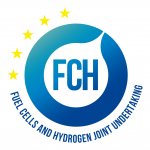While schools are already closed or about to close for the summer break in Europe, the work on the educational materials in FCHgo is just ramping up. The goal of FCHgo is to boost knowledge about hydrogen and fuel cell (HFC) technologies in schools. One action of the project is thus the development of a toolkit for teachers, addressing children from age 8 to 18.
On a beautiful June weekend the team of researchers charged with the preparation of the FCHgo toolkit met in Winterthur to further develop the stories, games, plays and factsheets about hydrogen energy and fuel cells technology that will go into the toolkit.
In this interview Tiziana Altiero, Federico Corni, Elisabeth Dumont and Hans Fuchs talk about the scientific bases of the FCHgo concept and give insight into their work on the toolkit materials.
FCHgo: To begin with, could you please shortly introduce us to your work on the FCHgo toolkit and the materials you are developing?
EPDM team: We are collecting existing materials (cards for playing energy games, an animation of the interaction of forces of nature) and producing some new ones (a story of how nature produces food or fuel—An Apple Story). Importantly, we are writing texts that should allow the teachers of young students to learn about FCH technology.
FCHgo pursuits a rather unorthodox approach, relying on stories and games as a medium to convey the basics of energy and HFC to pupils. Could you elaborate a bit more on the background of the FCHgo concept?
FCHgo makes use of pedagogy of narrative approaches to science developed at the University of Modena and Reggio Emilia, ZHAW in Winterthur, and the Free University of Bolzano in recent years. We base our approach upon the recognition of the power of imagination available to all of us and the imaginative (metaphoric and narrative) structure of macroscopic (continuum) physics. Moreover, the approach makes use of system science and systems thinking to produce a presentation of processes that is modern, extensive, and accessible.
FCHgo addresses quite a wide age range, from children about eight years in primary schools to youngsters of up to 18 years in secondary schools. How do you fulfill on different requirements for teaching, given the contrasting levels of understanding and experience in this age range?
This is one reason why we rely upon a narrative approach. If narrative is accessible to small children, if it allows them to understand important abstractions in our conceptualizations of phenomena in nature, and if the same abstractions appear in formal science, there is a chance of delivering materials that are useful for learners of different age groups.
Besides conceiving materials that stimulate the imaginative understanding by children, another goal for their design is to render them practice-oriented, namely in two respects. They shall be easy-to-implement, adapted to the needs of teachers as well as close-to-life, referring to real life applications of hydrogen. How do you incorporate these goals into your work?
We believe the most important point, in this respect, is the education of the teachers. If students are expected to benefit from an imaginative approach to science and technology, we certainly can hope the same to be true for teachers. “Easy to implement” then means that teachers become confident in understanding at least some important aspects of FCH technology. As far as “real life applications of hydrogen” is concerned, this should be a natural result of teachers dealing with the subject of hydrogen as a fuel and fuel cell technology for powering important applications.
FCHgo is not the first project on science education you conduct together, but the first one dedicated to hydrogen and fuel cells. Have you found any particularities or challenges that come with translating the subject into ready-to-teach materials?
Including hydrogen as a “force of nature” in our approach to other forces of nature (fluid, heat, electricity, motion…) means expanding upon the role of chemical processes. We find it rewarding to work on a subject that makes us think more deeply about the integration of chemical (and biological) phenomena into physics.
Last but not least, could you briefly outline the next steps for the materials’ development?
We believe we have now a clear overview of needs to be produced and to be completed. So, the next steps simply concern production: writing and illustrating of the Apple Story, writing a technical text for teachers, writing a manual for teachers allowing them to see how to turn principles, concepts, and ideas into concrete pedagogy, and so on.
Prof. Tiziana Altiero from the University of Modena and Reggio Emilia, Prof. Federico Corni from the University of Bozen-Bolzano and Prof. Hans Fuchs and Dr. Elisabeth Dumont from the Zurich University of Applied sciences lead the development of the FCHgo educational toolkit. They bring together long-standing experience in didactics of physics, having researched the ways to enhance human understanding and learning of natural sciences for many years. Besides their individual work in the field, they have conducted several research projects together examining the use of stories and images in science education. Corni, Fuchs and Dumont are founding members of the research centre ‘Metaphor and Narrative in Science. Imaginative Approaches to Learning and Communication’ (MANIS) at the Department for education and humanities of the University of Modena and Reggio Emilia.



